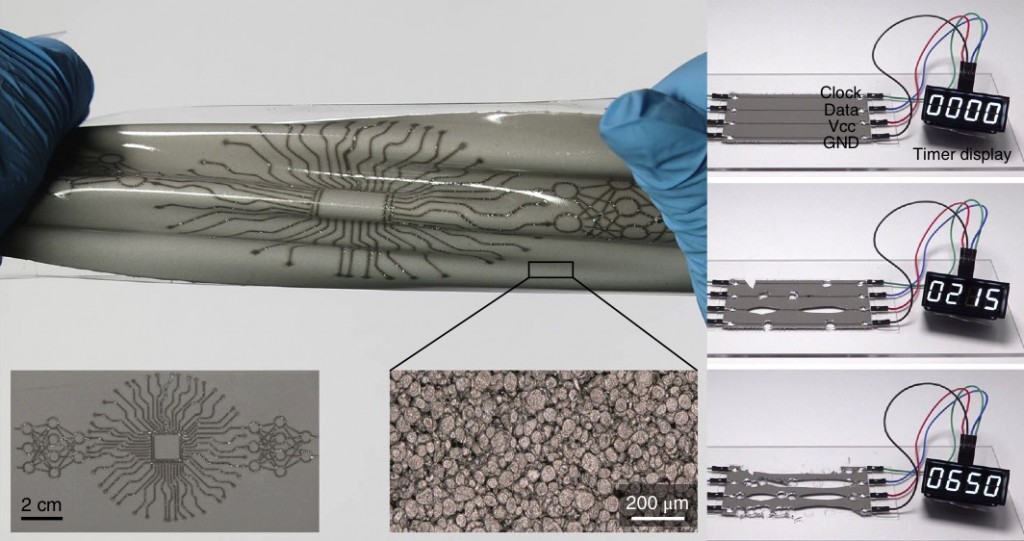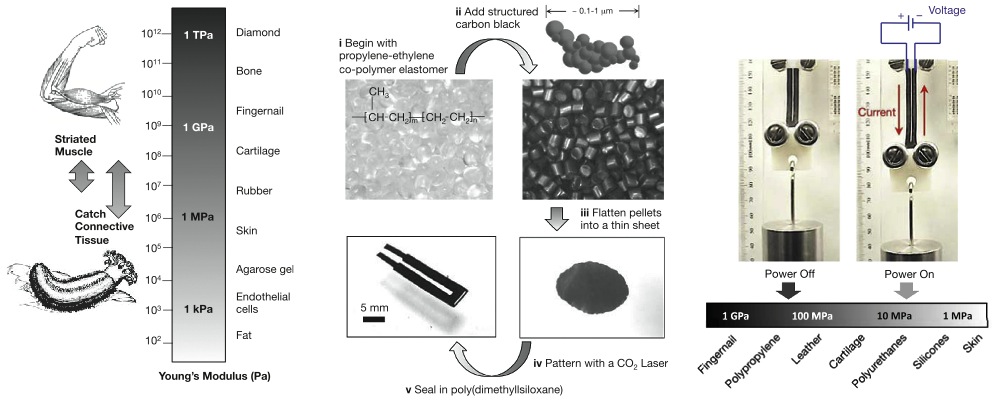For robots and machines to behave like soft biological organisms and be safe for contact with humans, they need to be made out of soft, lightweight, and deformable material. In particular, they require multifunctional composites that can serve as “artificial” skin, nervous tissue, and muscle. To address this, we are exploring new combinations of materials that exhibit unique combinations of electro-thermo-elastostatic properties and couplings.
Soft Multifunctional Rubber
We have recently discovered that elastomers embedded with a polydisperse suspension of liquid metal (LM) inclusions exhibit mesoscale properties never before seen in soft polymers. These LM-embedded elastomer (LMEE) composites can be tailored to have high electrical permittivity and thermal conductivity.

M. D. Bartlett, N. Kazem, M. J. Powell-Palm, X. Huang, W. Sun, J. A. Malen, and C. Majidi, “High thermal conductivity in soft elastomers with elongated liquid metal inclusions,” Proceedings of the National Academy of Sciences 114 2143–2148 (2017). [link]
N. Kazem, T. Hellebrekers, C. Majidi, “Soft Multifunctional Composites and Emulsions with Liquid Metals,” Advanced Materials 19 1605985 (2017). [link]
M. Bartlett, A. Fassler, N. Kazem, E. Markvicka, P. Mandal, C. Majidi, “Stretchable, high-k dielectric elastomers through liquid metal inclusions,” Advanced Materials 28 3726–3731 (2016). [link]
Electrically Conductive Liquid Metal Networks
LMEE composites can also be engineered to be electrically conductive. This is accomplished by applying intense surface pressure, which causes the LM droplets to rupture and form conductive pathways. Recently we found special compositions for which these pathways can exhibit a self-healing property — when cut, torn, or punctured, the droplets automatically form new conductive pathways in order to maintain electrical connectivity within a written circuit.

E. J. Markvicka, M. D. Bartlett, X. Huang, C. Majidi, “An autonomously electrically self-healing liquid metal-elastomer composite for robust soft-matter robotics and electronics,” Nature Materials in press (2018). [link]
A. Fassler, C. Majidi, “Liquid Phase Metal Inclusions for a Conductive Polymer Composite,” Advanced Materials 27 1928–1932 (2015). [link] [pdf]
Reversibly Tunable Elastic Rigidity
In order for soft materials to perform mechanical work, they must be able to tune their elastic rigidity. As with natural muscle and catch connective tissue, this rigidity change must span 1-2 orders of magnitude. Recently, we have developed a novel composite material capable of changing its tensile elastic modulus between ~1 to 100 MPa, similar in range to striated muscle. This is accomplished with a percolating network of carbon black in a thermoplastic propylene-ethylene co-polymer. The composite is rigid at room temperature and softens when heated through electrical current.

S. Rich, S. H. Jang, Y. L. Park, C. Majidi, “Liquid Metal-Conductive Thermoplastic Elastomer Integration for Low-Voltage Stiffness Tuning,” Advanced Materials Technologies 2 1700179 (2017). [link]
W. Shan, T. Lu, C. Majidi, “Soft-matter composites with electrically tunable elastic rigidity,” Smart Materials and Structures 22 085005 (2013). [link]
W. Shan, T. Lu, Z.H. Wang, C. Majidi, “Thermal analysis and design of a multi-layered rigidity tunable composite,” International Journal of Heat and Mass Transfer 66 271-278 (2013). [link]
